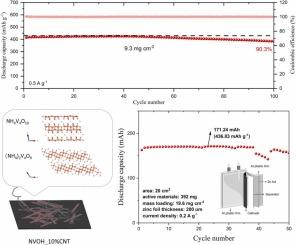Constructing a high-loading cathode via the synergistic effect of carbon nanotubes and ammonium vanadate for high-rate and long-cycle aqueous zinc-ion batteries
IF 6.3
2区 材料科学
Q2 CHEMISTRY, PHYSICAL
引用次数: 0
Abstract
Overcoming the sluggish Zn2+ transport kinetics and engineering high-mass-loading of active material on cathodes are urgent for practical high-performance aqueous zinc ion batteries (AZIBs). Because of their high theoretical capacity, diverse crystal structures and multivalent states, vanadium-based materials are extensively studied for the cathodes of AZIBs. Nevertheless, poor inherent conductivity and structure susceptible to collapse lead to limited cycling stability and low-rate performance. Therefore, in this study, the composite of ammonium vanadate and carbon nanotubes (NH4V4O10/(NH4)2V4O9/CNTs (NVOH_10 %CNT)) is synthesized by a simple hydrothermal method. The CNTs can form conductive networks to the increase conductivity for fast electron transport. At the same time, CNTs can also mitigate the structural collapse of NVOH. Therefore, the NVOH_10 %CNT//Zn cell displays a high specific capacity of 446.2 mAh g−1 at 0.3 A g−1 and 286.1 mAh g−1 even at a high operating current density of 20 A g−1. In addition, the capacity retention is 88.52 % after 5000 cycles at 20 A g−1. Even after 10000 cycles, the specific capacity remains 211.6 mAh g−1. Furthermore, a button cell with a high mass loading of 9.3 mg cm−2 exhibits a specific capacity of 425.7 mAh g−1 at 0.5 A g−1. In addition, the NVOH_10 %CNT//Zn pouch battery exhibits high area capacity (8.56 mAh cm−2). This work demonstrates a new and effective approach to design ammonium vanadate composite materials for cathodes of AZIBs.

利用碳纳米管和钒酸铵的协同效应构建高负载高倍率长循环锌离子电池阴极
克服Zn2+输运动力学迟缓的问题,实现活性物质在阴极上的工程化高质量加载,是实现高性能锌离子电池的迫切需要。钒基材料由于具有较高的理论容量、多样的晶体结构和多价态,被广泛用于azib阴极的研究。然而,较差的固有电导率和易坍塌的结构导致循环稳定性有限和低倍率性能。因此,本研究采用简单的水热法合成了钒酸铵与碳纳米管(NH4V4O10/(NH4)2V4O9/CNTs (NVOH_10 %CNT))的复合材料。碳纳米管可以形成导电网络,提高电子快速传递的导电性。同时,CNTs还可以减轻NVOH的结构崩塌。因此,NVOH_10 %CNT//Zn电池在0.3 a g−1和20 a g−1的高工作电流密度下显示出446.2 mAh g−1和286.1 mAh g−1的高比容量。在20 A g−1下,5000次循环后,容量保持率为88.52 %。即使在10000次循环后,比容量仍保持211.6 mAh g−1。此外,高质量负载为9.3 mg cm−2的纽扣电池在0.5 a g−1时的比容量为425.7 mAh g−1。此外,NVOH_10 %CNT//Zn袋状电池具有较高的面积容量(8.56 mAh cm−2)。本工作为设计钒酸铵复合材料的azib阴极提供了一种新的有效方法。
本文章由计算机程序翻译,如有差异,请以英文原文为准。
求助全文
约1分钟内获得全文
求助全文
来源期刊

Journal of Alloys and Compounds
工程技术-材料科学:综合
CiteScore
11.10
自引率
14.50%
发文量
5146
审稿时长
67 days
期刊介绍:
The Journal of Alloys and Compounds is intended to serve as an international medium for the publication of work on solid materials comprising compounds as well as alloys. Its great strength lies in the diversity of discipline which it encompasses, drawing together results from materials science, solid-state chemistry and physics.
 求助内容:
求助内容: 应助结果提醒方式:
应助结果提醒方式:


